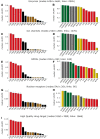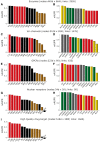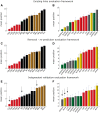Pioneering topological methods for network-based drug-target prediction by exploiting a brain-network self-organization theory
- PMID: 28453640
- PMCID: PMC6291778
- DOI: 10.1093/bib/bbx041
Pioneering topological methods for network-based drug-target prediction by exploiting a brain-network self-organization theory
Abstract
The bipartite network representation of the drug-target interactions (DTIs) in a biosystem enhances understanding of the drugs' multifaceted action modes, suggests therapeutic switching for approved drugs and unveils possible side effects. As experimental testing of DTIs is costly and time-consuming, computational predictors are of great aid. Here, for the first time, state-of-the-art DTI supervised predictors custom-made in network biology were compared-using standard and innovative validation frameworks-with unsupervised pure topological-based models designed for general-purpose link prediction in bipartite networks. Surprisingly, our results show that the bipartite topology alone, if adequately exploited by means of the recently proposed local-community-paradigm (LCP) theory-initially detected in brain-network topological self-organization and afterwards generalized to any complex network-is able to suggest highly reliable predictions, with comparable performance with the state-of-the-art-supervised methods that exploit additional (non-topological, for instance biochemical) DTI knowledge. Furthermore, a detailed analysis of the novel predictions revealed that each class of methods prioritizes distinct true interactions; hence, combining methodologies based on diverse principles represents a promising strategy to improve drug-target discovery. To conclude, this study promotes the power of bio-inspired computing, demonstrating that simple unsupervised rules inspired by principles of topological self-organization and adaptiveness arising during learning in living intelligent systems (like the brain) can efficiently equal perform complicated algorithms based on advanced, supervised and knowledge-based engineering.
Figures










Similar articles
-
Modelling Self-Organization in Complex Networks Via a Brain-Inspired Network Automata Theory Improves Link Reliability in Protein Interactomes.Sci Rep. 2018 Oct 25;8(1):15760. doi: 10.1038/s41598-018-33576-8. Sci Rep. 2018. PMID: 30361555 Free PMC article.
-
Network-Based Drug-Target Interaction Prediction with Probabilistic Soft Logic.IEEE/ACM Trans Comput Biol Bioinform. 2014 Sep-Oct;11(5):775-87. doi: 10.1109/TCBB.2014.2325031. IEEE/ACM Trans Comput Biol Bioinform. 2014. PMID: 26356852
-
Inferring Interactions between Novel Drugs and Novel Targets via Instance-Neighborhood-Based Models.Curr Protein Pept Sci. 2018;19(5):488-497. doi: 10.2174/1389203718666161108093907. Curr Protein Pept Sci. 2018. PMID: 27829347
-
Comparative analysis of network-based approaches and machine learning algorithms for predicting drug-target interactions.Methods. 2022 Feb;198:19-31. doi: 10.1016/j.ymeth.2021.10.007. Epub 2021 Nov 1. Methods. 2022. PMID: 34737033 Review.
-
Revealing Drug-Target Interactions with Computational Models and Algorithms.Molecules. 2019 May 2;24(9):1714. doi: 10.3390/molecules24091714. Molecules. 2019. PMID: 31052598 Free PMC article. Review.
Cited by
-
Can local-community-paradigm and epitopological learning enhance our understanding of how local brain connectivity is able to process, learn and memorize chronic pain?Appl Netw Sci. 2017;2(1):28. doi: 10.1007/s41109-017-0048-x. Epub 2017 Aug 30. Appl Netw Sci. 2017. PMID: 30443582 Free PMC article.
-
Hyperbolic matrix factorization improves prediction of drug-target associations.Sci Rep. 2023 Jan 18;13(1):959. doi: 10.1038/s41598-023-27995-5. Sci Rep. 2023. PMID: 36653463 Free PMC article.
-
Chemogenomic Approaches for Revealing Drug Target Interactions in Drug Discovery.Curr Genomics. 2021 Dec 30;22(5):328-338. doi: 10.2174/1389202922666210920125800. Curr Genomics. 2021. PMID: 35283667 Free PMC article. Review.
-
Modelling Self-Organization in Complex Networks Via a Brain-Inspired Network Automata Theory Improves Link Reliability in Protein Interactomes.Sci Rep. 2018 Oct 25;8(1):15760. doi: 10.1038/s41598-018-33576-8. Sci Rep. 2018. PMID: 30361555 Free PMC article.
-
DLDTI: a learning-based framework for drug-target interaction identification using neural networks and network representation.J Transl Med. 2020 Nov 13;18(1):434. doi: 10.1186/s12967-020-02602-7. J Transl Med. 2020. PMID: 33187537 Free PMC article.
References
-
- Paul SM, Mytelka DS, Dunwiddie CT, et al.How to improve R&D productivity: the pharmaceutical industry’s grand challenge. Nat Rev Drug Discov 2010;9(3):203–14. - PubMed
-
- Munos B. Lessons from 60 years of pharmaceutical innovation. Nat Rev Drug Discov 2009;8(12):959–68. - PubMed
-
- O’Connor KA, Roth BL.. Finding new tricks for old drugs: an efficient route for public-sector drug discovery. Nat Rev Drug Discov 2005;4(12):1005–14. - PubMed
-
- Yamanishi Y. Supervised Bipartite Graph Inference. NIPS, 2008, 1841–1848. MIT press, Cambridge, USA.
-
- Bleakley K, Biau G, Vert J-P.. Supervised reconstruction of biological networks with local models. Bioinformatics 2007;23(13):i57–65. - PubMed
Publication types
MeSH terms
LinkOut - more resources
Full Text Sources
Other Literature Sources
Research Materials

